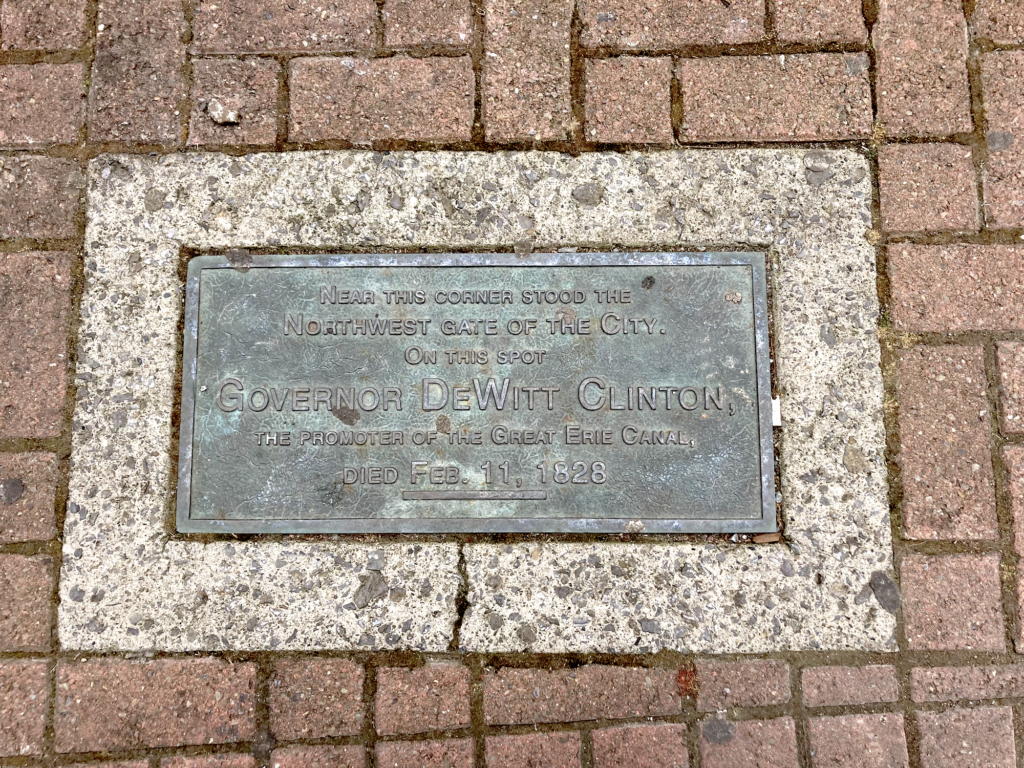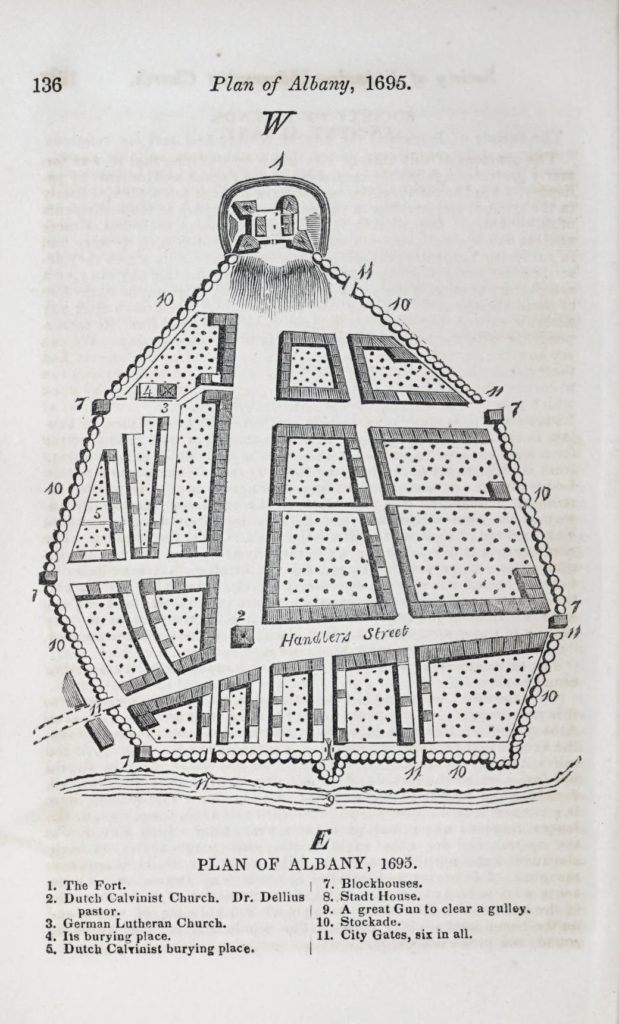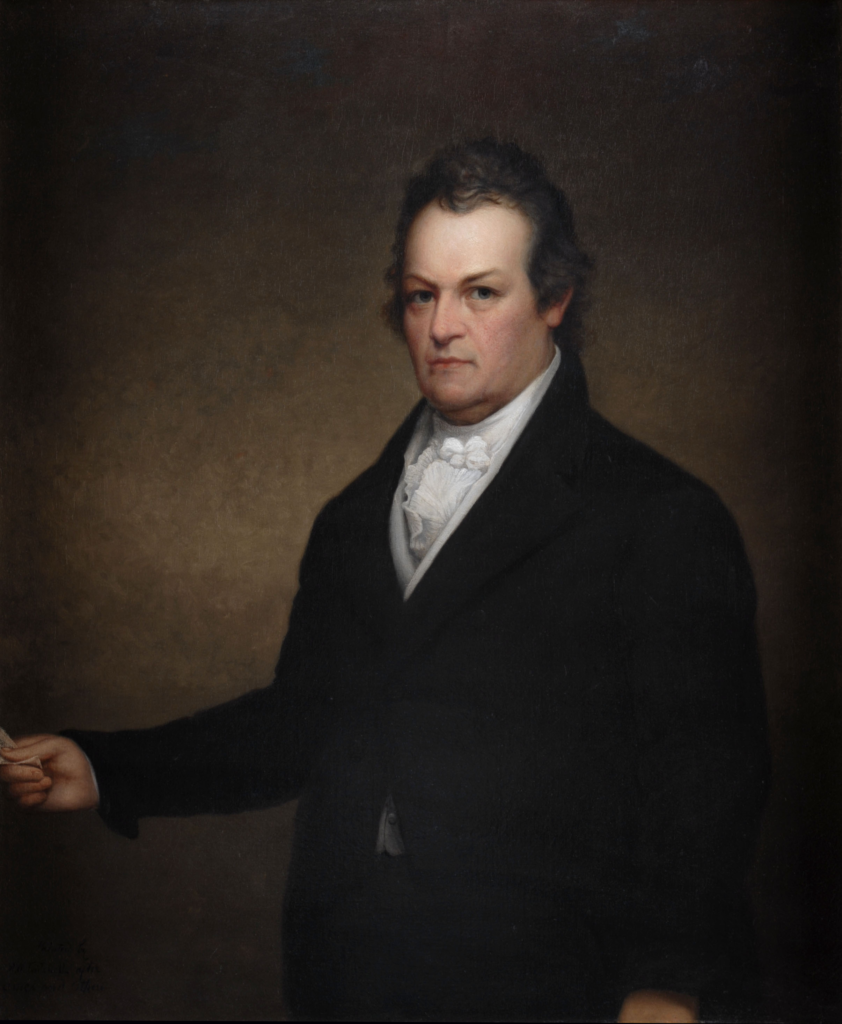Continuing our series on the tablets installed at important sites around the city of Albany in honor of the bicentennial of its charter, in 1886:
Tablet No. 28 — North-West Gate.
Bronze tablet, 9×13 inches, set in building occupied by Johnston & Reilly, North Pearl street. Inscription :
“Here Stood the Northwest Gate of the city. On this Spot De Witt Clinton, the Projector of the Great Erie Canal, Died February 11, 1828.”
That’s how the Bicentennial Commission reported the tablet’s placement. In fact, the Albany Argus reported in 1914 that it was never set in that building, and was instead in a granite bock in the sidewalk. And the word “projector,” an odd description to say the least, was mercifully changed to “promoter.” Miraculously, it is still there, in front of the building on the southeast corner of North Pearl and Steuben.

While the type looks right, the lack of any indications of the foundry or that it is a bicentennial marker makes us wonder if this could be a replacement. It looks exactly the same as the nearby “Old Lansing House” marker, which does bear a maker’s name and which we also suspected to be a replacement.
This 1695 map shows the location of the northwest gate of the city:

The marker raises the interesting question of just how late Albany remained a walled, gated city, but that’s not a question we could easily find the answer to. We find reference to it at least as late as 1715, when, according to the Albany Evening Journal in 1859:
The stockade at this time [1715] extended no further south than Hudson street, and was limited on the north by Steuben street; the Fort formed the western barrier, and the river the eastern. Within these narrow limits there was a population of about 3,000, and a garrison of 300 more.

In case you don’t know, DeWitt Clinton, born in what is now New Windsor, was elected first to the New York State Assembly and then to the Senate. He was then appointed to the U.S. Senate (to fill a vacancy), left that because he did not care for life in the very new District of Columbia, and then was appointed mayor of New York City. He won a special election to fill a vacancy as Lieutenant Governor of New York, then ran for president and lost to James Madison. He won a special election for Governor of New York in which he was the only candidate in 1817, managed to be re-elected in 1820, and then was not renominated by his party. Then somehow, in 1824, he was elected again and served another two terms, until his death at 58 in 1828.
Probably more important than any of his terms in office was his advocacy for the Erie Canal, derisively known as “Clinton’s Ditch.” He served on the Canal Commission from its creation in 1810 until 1824.
As for the death of DeWitt Clinton, a biography of Clinton by James Renwick from 1840 says that he suffered in his closing days from “dropsy of the chest, affecting in an especial degree the heart and lungs” — today we’d call that edema. “His death was without warning, and while his friends anticipated no immediate danger. It took place on the 11th of February, 1828, in the presence of his eldest son, who acted as his private secretary. He had taken a drive in the morning, visited the Capitol, and transacted business as usual. In the afternoon he wrote up his diary, and perused all the letters received by the evening mails, and was thus engaged until within a few minutes of his death.”
The plaque marks the site of Clinton’s home, which is now numbered as 59 North Pearl Street. The original building was constructed by merchant Goldsbrow Banyar in 1792. Clinton lived there from 1819 until his death. While the building has been much altered, there are still some original elements on the Steuben Street side of the building – Diana Waite in Albany Architecture points to the brownstone basement and the Flemish bond brickwork.

A reader on Facebook asked us a very interesting question that we hadn’t considered: “Where does the name DeWitt come from?” Ancestry.com says it’s from both Dutch and Flemish, as a nickname for someone with white or very fair hair or an exceptionally pale complexion. Essentially: “The White.”
